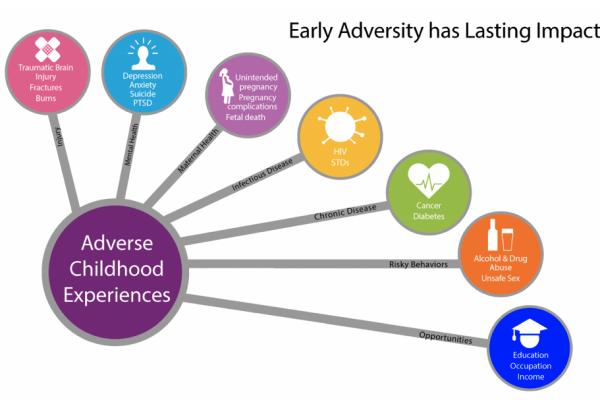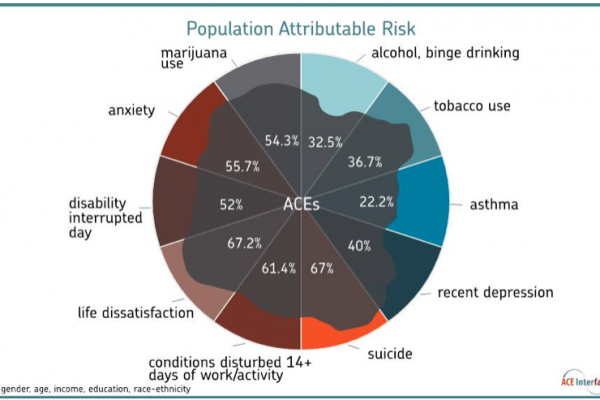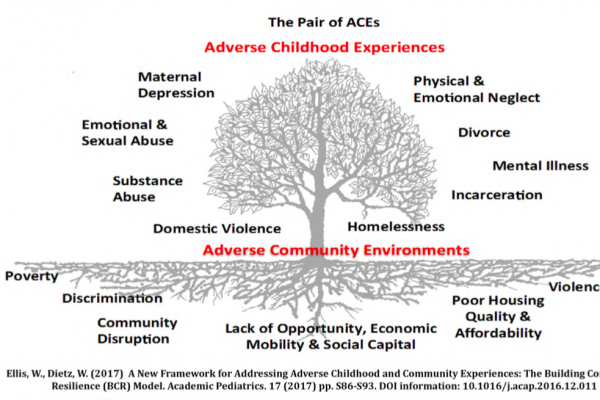In the state of Washington and elsewhere, communities have reduced rates of a host of health and social problems simultaneously, by focusing on the underlying roots of the problems. Groundbreaking scientific research is pointing to some common roots of many health and social well-being issues facing our families and communities. A landmark study by the CDC and Kaiser-Permanente, of over 17,000 people found that people who have a high number of Adverse Childhood Experiences (ACEs) (e.g., abuse, alcoholism in the home) end up with increased risk of 7 of 10 of the leading causes of death, such as heart disease and suicide. Other research has found strong correlations between ACEs and a wide range of negative health and behavior outcomes, for example:

Source: CDC web site
This new research is game changing and has catalyzed a movement that has gained significant traction in the last three years. For those working on environmental change or public health, we always talk about getting at the “root cause.” In my experience working on sustainability, we shifted from focus on one environmental issue at a time to working upstream to redesign and eliminate waste, excess energy use, toxics, etc. What I see in ACEs is a similar way to go upstream toward prevention rather than treatment once the harm is done.
This graphic illustrates the real potential here. “Population attributable risk” means the portion of a disease or condition caused by ACEs. In this image, you can see what a big percent of these outcomes relate to ACEs. This means if we reduce the prevalence of ACEs (e.g., shrink the gray part), many of these problems can be reduced simultaneously.

Source: ACEInterface
Institutions and cross-sector collaborations in communities are applying this research and finding ways to reduce adverse childhood experience occurrence and to interact with those who have experienced ACEs in ways that are “trauma informed.” The aim is to break the cycle of ACEs being passed from one generation to the next. A community in Cowlitz county in Washington shifted from a focus on direct service programs to working to “improve parent skills so they can give sound advice and be good mentors to their children, and, in turn [parents] will gain skills and relationships to give sound advice to the community—and that advice will make a better system of help for them and for other families.” See more details in this Self-Healing Communities report. These were results they achieved over 10 to 15 years:
- Births to teen mothers went down 62% and infant mortality went down 43%;
- Youth suicide and suicide attempts went down 98%;
- Youth arrests for violent crime dropped 53%;
- High school dropout rates decreased by 47%;
Much can be learned from people with high ACE scores who still flourish. Emerging research in related fields is rapidly advancing our understanding of what supports or hinders healthy human development. These fields include:
- Neurobiology– understanding how toxic stress, trauma, and neglect can affect the development of the brain.
- Epigenetics– understanding how effects of toxic stress can pass from one generation to the next, and how life circumstances affect how genes express themselves.
- Resilience– understanding how the brain and body can heal and adopt new patterns and behaviors, e.g., neuroplasticity.
The science shows that the impacts of childhood trauma are common and widespread, affecting people from all classes and identities. According to this CDC report, surveys of adults show about 62% report experiencing at least one ACE with one in four experiencing three or more. Surveys of caregivers show 22% of children have experienced two or more ACEs. There is a lot to learn about this research and its implications.
If a child has strong levels of relational support, e.g., caring attentive relationships, that can buffer the effects of adverse events. It’s also evident that institutions can cause additional harm, what is called “institutional betrayal,” such as when a young woman reports a rape and is shamed and disbelieved or a child acting out from problems at home is expelled from school. All of this research has immediate relevance for many aspects of our society, such as education, social services, criminal justice, and health care.
Many see this “trauma-informed” lens and research as the next wave of prevention work in public health and community revitalization. For example, we are excited to be working with the Greater Nashua Public Health Advisory Council in southern NH who are using a trauma-informed approach as the core of their public health prevention work. Taking a more complete view, we can see that Adverse Community Environments contribute to ACEs, as this graphic illustrates:

Much of the cross-sector collaborative work underway in communities is aligned toward reducing the pair of ACEs, e.g., addressing racial equity, affordable housing, focusing on systemic change, centering the needs and engagement of those marginalized, and restoring healthy relationships. These issues relate and affect each other. The Pair of ACEs points us to a unifying vision of preventing and healing intergenerational cycles of trauma. A key part will be how we create environments where people feel belonging, a sense of safety, and have opportunities to participate and thrive.
“Social support is the most powerful protection against becoming overwhelmed by stress and trauma. The critical issue is reciprocity: being truly heard and seen by the people around us, feeling that we are held in someone else’s mind and heart.”– Bessel Van der Kolk, The Body Keeps the Score.
We are excited to be co-hosting a two-day training with Emily Daniels of HERE This NOW, on Understanding and Initiating Trauma-Informed Change on January 16-17, 2020 in Hancock NH.
To learn more, I recommend:
- TEDTalk video from pediatrician Nadine Burke Harris, who is now the Surgeon General of California.
- How Childhood Trauma Can Make You a Sick Adult, video from one of the original researchers.
- PACEs Connection: an on-line hub of a community of practice related to positive and adverse childhood experiences.
- Essentials for Childhood Framework from the CDC
- The work of Sarah Peyton, including on-line classes and Your Resonant Self book
- HereThisNow – resources on trauma-informed classrooms and systems change.
